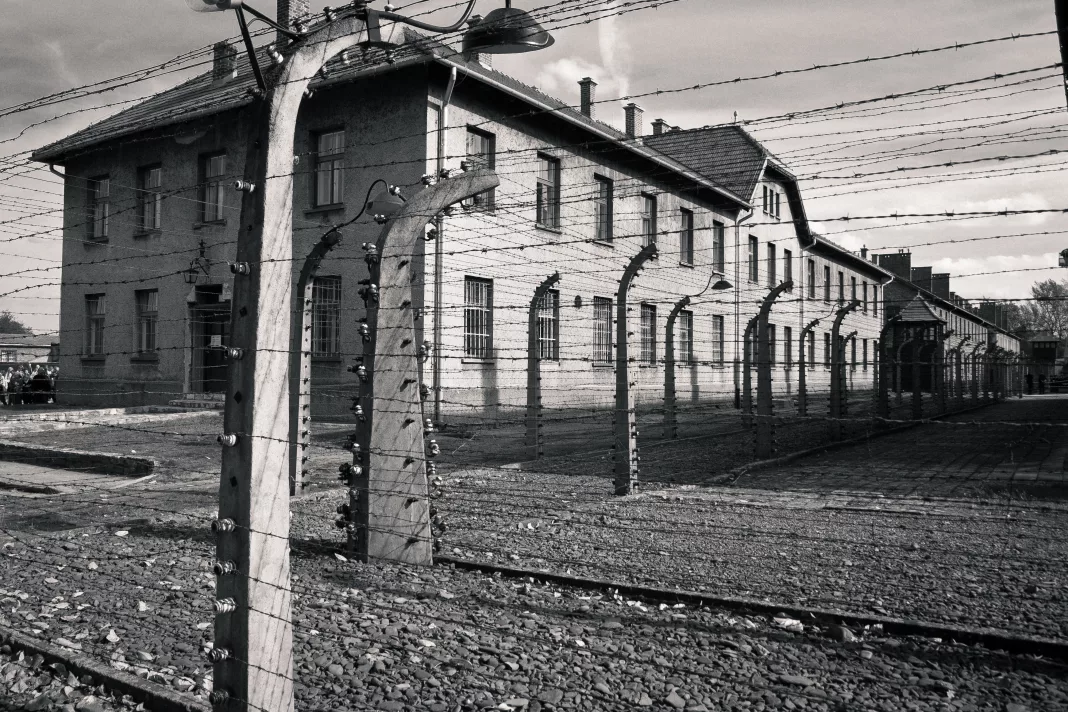In the first chapter of Martin Amis’ 2014 novel The Zone of Interest, Golo Thomsen, a Nazi soldier, describes the passing of a lorry revealing its ‘cargo’ to the newly arrived French inmates of Auschwitz-Birkenau. To Thomsen, it’s ‘nothing more than a day’s natural wastage from KL1, on its way to KL2. But of course our Parisians let out a great whimpering howl’. His euphemisms are obvious, yet they are emblematic of the culture of ‘seeing without seeing’ that cast its shadow over the National Socialist period in Germany. Jonathan Glazer’s recent film adaptation of the novel captures this same atmosphere of avoidance, but does so through its visual language rather than through Amis’ sardonic prose. Their shared title, ‘The Zone of Interest’, was the commonly used term which euphemistically referred to the restricted zone surrounding the death camp. It is emblematic of the industrial levels of mass murder that the Nazis committed: reducing human suffering to numbers, and human life to ‘cargo’.
Glazer does not ease us into this horrific world. The first two minutes of the film show only a blank, black screen paired with Mika Levi’s deafening and sparse score. There is no narrative exposition: we are thrown headfirst into the daily life of the Höss family. Rudolf Höss, the patriarch and longest serving Auschwitz Kommandant, and his wife, Hedwig, live in a sizeable house and share a garden wall with the death camp. We watch them care for their children, entertain guests, and be attended to by servants. The servants are most likely prisoners whose one wrong move could result in them being sent back over the wall. They are mostly treated as an invisible nuisance by the Höss family, yet on one occasion, following the early departure of her mother, Hedwig threatens death upon the servant girl as easily as scolding her for burning toast.
Hedwig is perhaps the most interesting character of the film, brilliantly portrayed by actress Sandra Hüller. There is something infantile about her, and though she spouts Nazi rhetoric more than her husband, there is a sense that she does not really understand the words she says, or perhaps she has regressed in an effort to distance herself from them. When her mother visits, Hedwig takes her on a tour of the garden, and jokingly brags at one point that she has been nicknamed the ‘Queen of Auschwitz’. Her garden, like her nickname, is an effort to make light of the atrocities being committed, yet the foundations, the very soil, are inseparable from death. In one scene, a prisoner tills ash into the ground; death becomes the fertiliser for Hedwig’s lush, green Eden. Nonetheless, Hedwig’s sincere or feigned ignorance allow her to be fiercely proud of the life she and her husband have built.
Rudolf Höss’ feelings towards his ‘job’ are more ambivalent. He cares deeply for animals and his children. He takes his boots off before he goes upstairs. He is as childlike as his wife, teasing her from his separate, single bed about her French perfume. The only hint that he feels any guilt comes towards the end of the film. He is relocated to Oranienburg near Berlin, and after attending a party, calls Hedwig and recounts pondering how long it would take to gas the ballroom. It is the film’s most direct allusion to the atrocities he has committed, and, though earlier his doctor had found him to be physically healthy, he begins gagging in the stairwell. The film then abruptly cuts to the modern day as cleaners sweep the gas chambers and wipe down the ovens for imminently arriving tourists. The irony of cleaning these spaces to make them more ‘palatable’ for modern day tourists is as contradictory as Hedwig’s garden of death. The film is less about the ‘banality of evil’, but rather the sanitization of it.
The Zone of Interest ultimately ends as it begins, with the same black screen and deafening audio. There are other instances of these Nazi flag-coloured scenes throughout the film. As the sounds of gunshots fill the garden in one scene, Glazer redirects us to a close-up of a flower that dissolves into a bright red block of colour. In another scene, Glazer films the white sky above Auschwitz accompanied by the sounds of children crying. These more abstract scenes, along with the folkloric atmosphere of the scenes where a Polish girl plants apples for the inmates, were the most moving. Their simplicity forcing us to reflect – forcing us to reflect on the possibility of our own evil.


